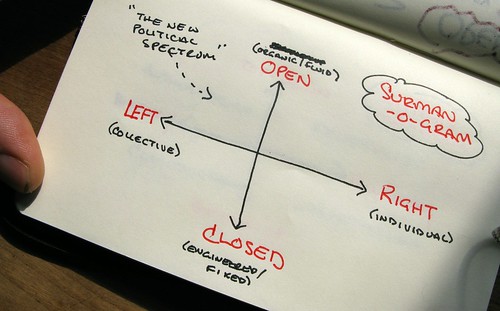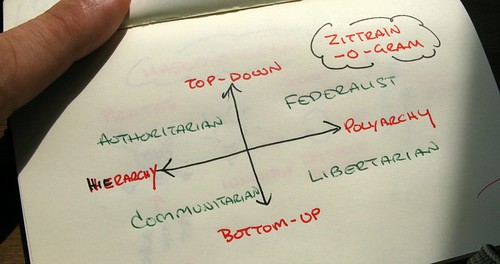Over the past week, I’ve been reflecting on the ideas of two people: Jonathan Zittrain (a professor) and Matt Mason (a pirate, or at least a fan of pirates). This has got me thinking about the ‘political compass question’ again, which goes something like this …
Right and left just aren’t enough anymore. We don’t live in a world where collective vs. individual sums up who we are (if it ever did). In fact, the much bigger tensions in today’s world are: democracy vs. authority; diversity vs. singularity; ecumenicism vs. fanaticism. We are in a struggle between open and closed.
The thing is, most people still see the world through one-dimensional-political-spectrum-goggles. Sure, we hack around this. Youth culture. Open source. Punk capitalism. Matrixed social movements. Internet culture. We know how things are changing, and we are accelerating the change. Yet, despite these hacks, the imaginative frame that organizes political parties, schools, governments, big media, laws and, to a certain degree, our identities is stuck in the left-right mud. This is true almost everywhere I have been in big, bad world.
We need a new political compass, urgently. The left vs. right spectrum has hit a wall. It no longer helps us see what’s possible, or even what’s necessary. We need (at least) another dimension to help us explore the possibilities of open vs. closed on a mass scale. I’ve been playing with this diagram for a while now:
Left vs. right thinking has us log jammed on pressing issues like the environment, intellectual property and the evolution of markets. A few people are making breakthroughs on these topics, and they seem to be doing so by dumping the left vs. right mindset for open thinking. Grafting open (and closed) onto the map that focuses our political imagination could help us break the logjams on a much larger scale.
This idea is not new. Paul Ray called for a new political compass in 1994 (and then trademarked the term. Silly man.). More importantly, I stumble across people hinting at the need to add open vs. closed (or, at least, open) into the broad conversation about economics, society and politics almost every week. Paul Hawken’s book on new social movements. Matt Mullenweg‘s off the cuff comments about the real meaning of open source (last 10 mins of this talk). Meg Wheatley‘s articles about emergence. All are contributing to the debate and evolution of a new political compass, even if they don’t know they are in the game.
This where Zittrain (the professor) and Mason (the pirate) come back in. I think they know they are part of the game, and are trying to help rebuild our politcal map.
Zittrain is concerned that the Internet is about to be killed off by the very culture of openness that it created. As outlined in great blog coverage of a recent Zittrain talk, the argument goes: folks like pirates and virus makers are using the bottom up nature of the Internet to do things that piss people off. This plays into the hands of governments and businesses who want to ‘fix’ things with laws and technologies that will take away the flexible, bottom up qualities of the internet. The only solution is to amp up our efforts police the Internet using well structured, rule based community policing like we see in Wikipedia.
While this argument is interesting, and the threats are very real, what really caught my eye was the Zittrain-o-gram used to show the political terrain upon which all this is happening. It looked something like this:
What I like about this diagram is that it shows the tension between closed (aka top down) and open (aka bottom up). These are recognized as distinct terrains on the map. We need maps like this. What I don’t like so much is the way this sets up the rigorously open (the communitarians) and the anarchically open (the pirates) camps as enemies.
Matt Mason’s new book, The Pirate’s Dilemma, helps explain why. Starting with Walt Disney’s use of fairy tales, winding through punk / hip hop / graffiti / open source, and ending up with pervasive, transient remix culture, Mason argues that pirate culture (and youth culture) is a major force of innovation. Yes, it competes with both traditional business and (sometimes) organized approaches to open. But, in doing so it forces more established players to take pirate innovations on board, increasing efficiency in the market, creating better products for consumers and (often) making the world a better place.
Mason diagrams this by inverting the traditional prisoner’s dilemma diagram (altruism vs. selfishness) into a pirate’s dilemma diagram (altruism AND selfishness). The bottom like is that market players and society win if the integrate the innovations of pirates. Those who don’t lose. The diagram looks like this:

I like this diagram. Just like transcending right vs. left, turning the prisoner’s dilemma inside out helps us expand beyond our limited 20th century political imaginations. More importantly, it shows that the pirates are actually contributing to the success of other players in society, including the rigorously open folks that Zittrain encourages us to back (and we should back them, for sure).
For me, the opportunity here is getting the open meme onto the broad social, political and economic map. As we do this, we should see the Zittrain’s communitarians and Mason’s pirates as yin and yang. Something like this:
We need both halves of open. And, while each group needs to insist on doing things its own way, we also need to recognize each other as allies. As Boris Mann blogged yesterday:
Basically, sniping other open projects isn’t cool. … The “enemy” here is proprietary systems. They are not good for business, they are not good for communities, and they are not good for the growth of this interlinked web of data that is becoming truly useful.
While Boris is talking about software, the same idea extends to the whole open terrain. We don’t need to agree on everything (that’s the point, right). We just need to make it clear that open offers possibilities that most people can’t even imagine yet, and that closed is not what we want. My sense is that we’re on the cusp of building the maps and memes we need to make this message crystal clear.



